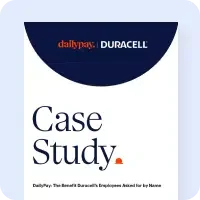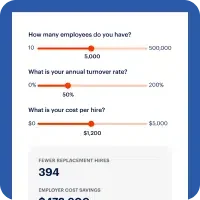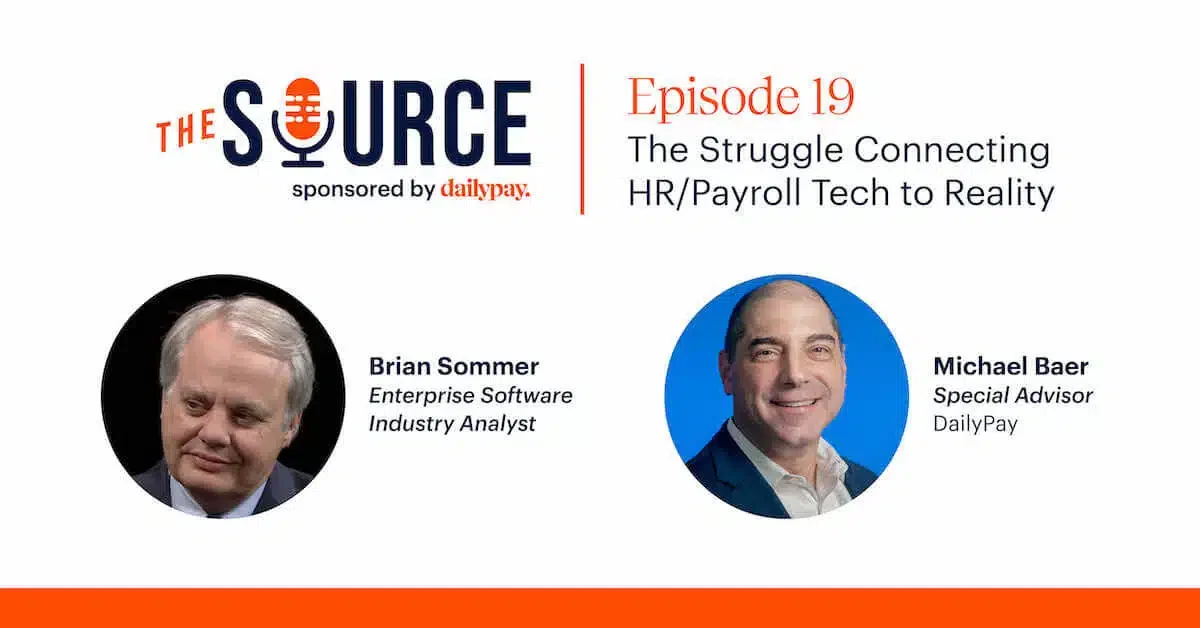Technological solutions for HR and payroll can be enigmatic. On the one hand, there is promise for delivery of programs or solutions that are compliant, transformative and have measurable positive impacts for the organization. On the other hand, some tech hitting the HR and payroll market works well for one thing but lacks in another. And some using these new applications end up applying them as “Band-Aids on top of bigger problems.”
This is the theme of a recent Source by DailyPay podcast featuring well-regarded enterprise software industry analyst Brian Sommer, as he talked about the struggle connecting HR/Payroll tech tools to reality.
A key observation by Sommer is that for technological solutions, there are a lot of HR and payroll needs and wants, but in the larger tech-stack scheme for an organization, investment in these administrative tools often end up “sitting near the bottom of that stack” of overall digital transformation efforts. At a recent HR technology conference, Sommer said that those looking for HR enterprise solutions ended up with one or two non-comprehensive applications. “These are stopgaps,” he said, because the budgets are not there.
And even when a more comprehensive cloud-based solution is purchased because it “sounds fantastic,” many vendors are really just doing a straight transfer of data from old systems and putting it in the new system, a scenario Sommer calls “mapping right over all their problems.”
This can result in a “huge customer support liability,” Sommer said.
Organizations end up with data not easily fitting across the spectrum of applications. Key data elements leading up to the balance sheet, for example, cannot be populated directly from the payroll system. So companies feel compelled to “massage the data,” Sommer said.
By massaged data, Sommer didn’t mean someone is cooking the books, but that manual interfaces need to be set up to move the data (in this case, payroll data) into the right sections of the finance systems. Some employers “are building these incredible sub-systems” to make these connections happen. As inefficient and a drain on resources as they are, these programs really are necessary in many cases, even in the age we live in with the solutions that have been developed.
In terms of what the providers are doing to minimize the gaps in service applications, Sommer said it would be ideal if we can “freeze everything around a problem” and resolve it, but “that’s not the way the real world works.” Governmental requirements are constantly changing for hiring and termination, for example. Other external dynamics include the reaction to the pandemic, societal shifts, generational changes in the workplace and “The Great Resignation.” These all hinder the ability to fix issues.
There are some positive developments that are transformational, however. Sommer identified what he called “the advanced technologies” that include artificial intelligence, machine learning, chatbots, robotic process automation and the applications surrounding big data. He noted these are transformational because they create a marked departure from what HR and finance people have been used to, which have been primarily analyzing transactions and internal transactions. The new technology broadens and enhances the opportunities to provide more complete services.
Chatbots have been useful, according to Sommer, especially for tracking and identifying trends in the searches and questions being asked. Also, some AI and machine learning tool apps help remove potentially discriminatory information from the data used for recruitment. Then there is process automation, which hits the payroll-to-general ledger interface, he said.
These tools don’t come without risk, however. They have to be managed appropriately by people skilled enough to know how to get the right output by providing the system with the proper input and guidance. For example, for applicant tracking systems, one can inadvertently weed out or amplify prior biases without realizing it, he said.
Another concern Sommer addressed with high tech in HR and payroll is the inconsistent customer service or follow-up from implementing a new widget or system. The focus for these companies has been to obtain clients, and not as much attention is applied to retaining them. It’s a syndrome. “Once they’ve got you locked in, they tend to forget about you,” said Sommer.
Clients are uncertain how to navigate the protocols to advance a concern so it can be addressed, and providers have difficulty in taking up and resolving some issues.
Related to the general customer service shortfall Sommer observed with HR and payroll tech providers are the impact of changes in leadership of these organizations. Founders of tech solution companies “are akin to televangelists,” he said. “People want to buy into that future-oriented story,” Sommer added. Those that succeed the founders are not as adept at “selling the vision,” and are more focused on “hitting the numbers” for financial success. They are “long on marketing and short on delivery,” Sommer said.
With new technology, there is an ability to see indicators so organizations can better understand who is looking to leave the employer, for example. An analyst’s eye is necessary, and though the windows into identifying those indicators are becoming more available, they are underutilized, Sommer said.
You can access the video of the full podcast here and subscribe to other Source by DailyPay episodes here.
DailyPay is building technology and the mindset to reimagine the way money moves, from the moment work starts. DailyPay’s pay experience goes beyond compliance and flexibility. Through the DailyPay BalanceTM, the technology seamlessly integrates with a variety of pay systems to continuously and accurately track earnings, makes them accessible and accounts for the amounts, so the payroll team doesn’t have to take any action.
For additional resources on this topic, see:
- Employees Rising: Connecting HCM Growth and On-Demand Pay
- Earned Wage Access 2021: Retention and Hiring Impact
- The Implementers
- Payroll’s Role is Changing: Here’s How New Technology Will Change it More
- How Full-Service On-Demand Pay Works for Our Payroll Team
- Aite-Novarica Group Research Finds that DailyPay is a Payday Loan Killer and Overdraft Eliminator
- White-Label On-Demand Pay for HCM and Payroll Companies is Now Possible With DailyPay ExtendPX













